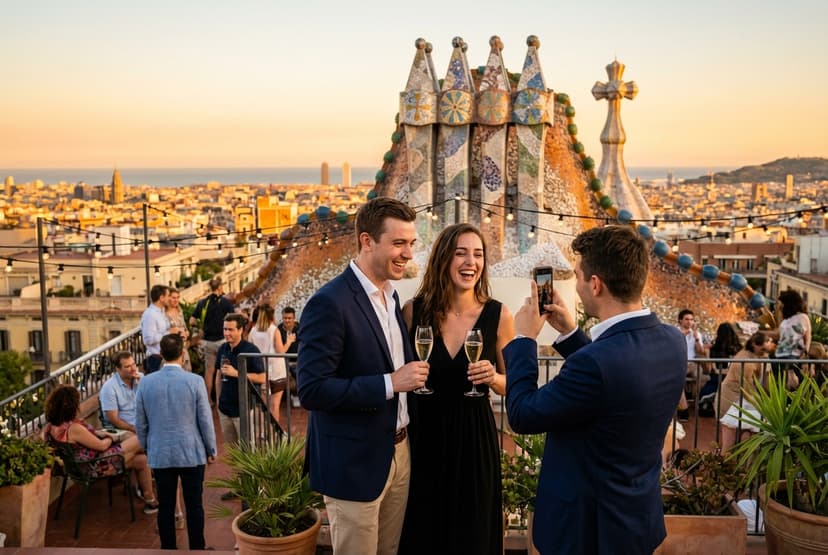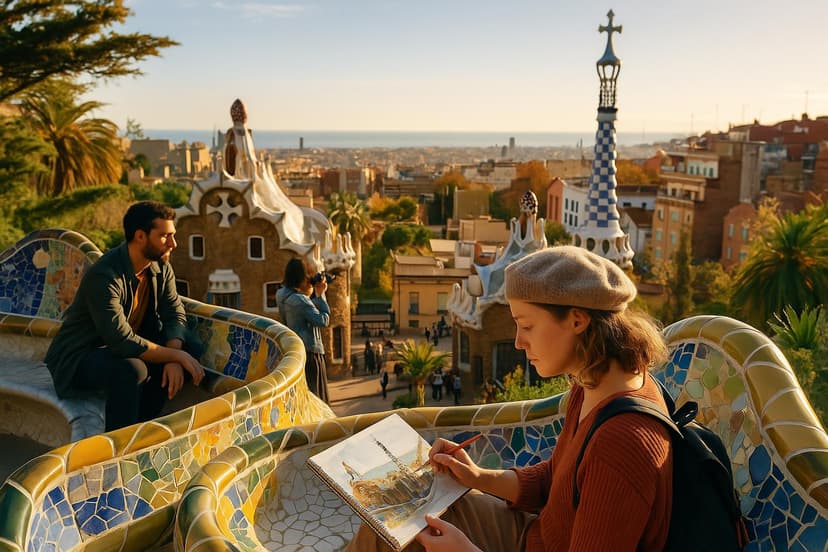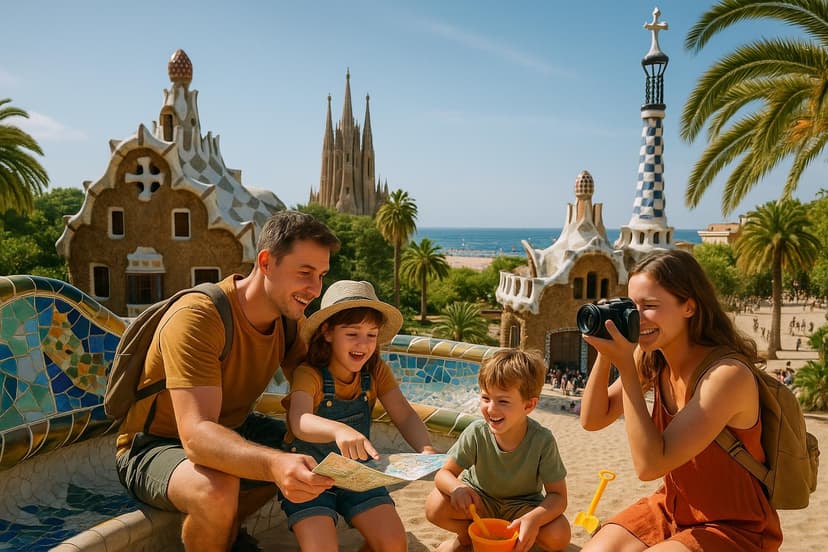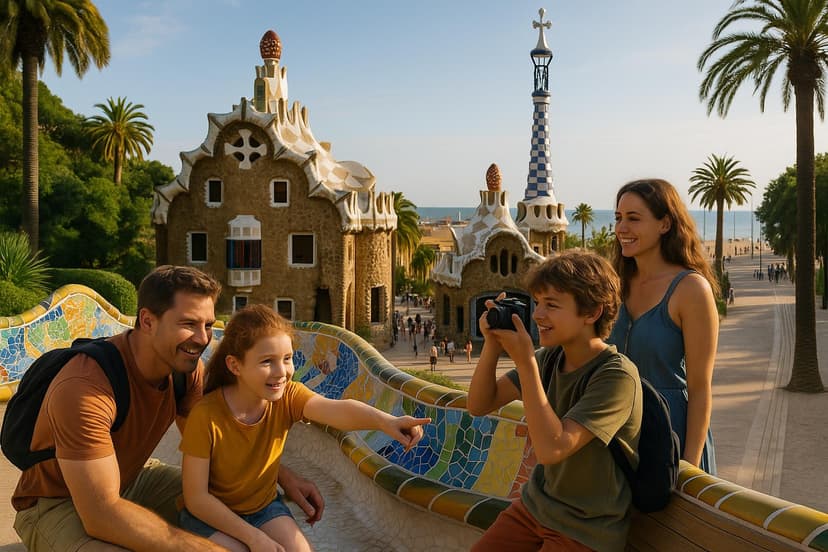Gaudí Curves to Poblenou Studios — 3‑Day Barcelona for Design Enthusiasts
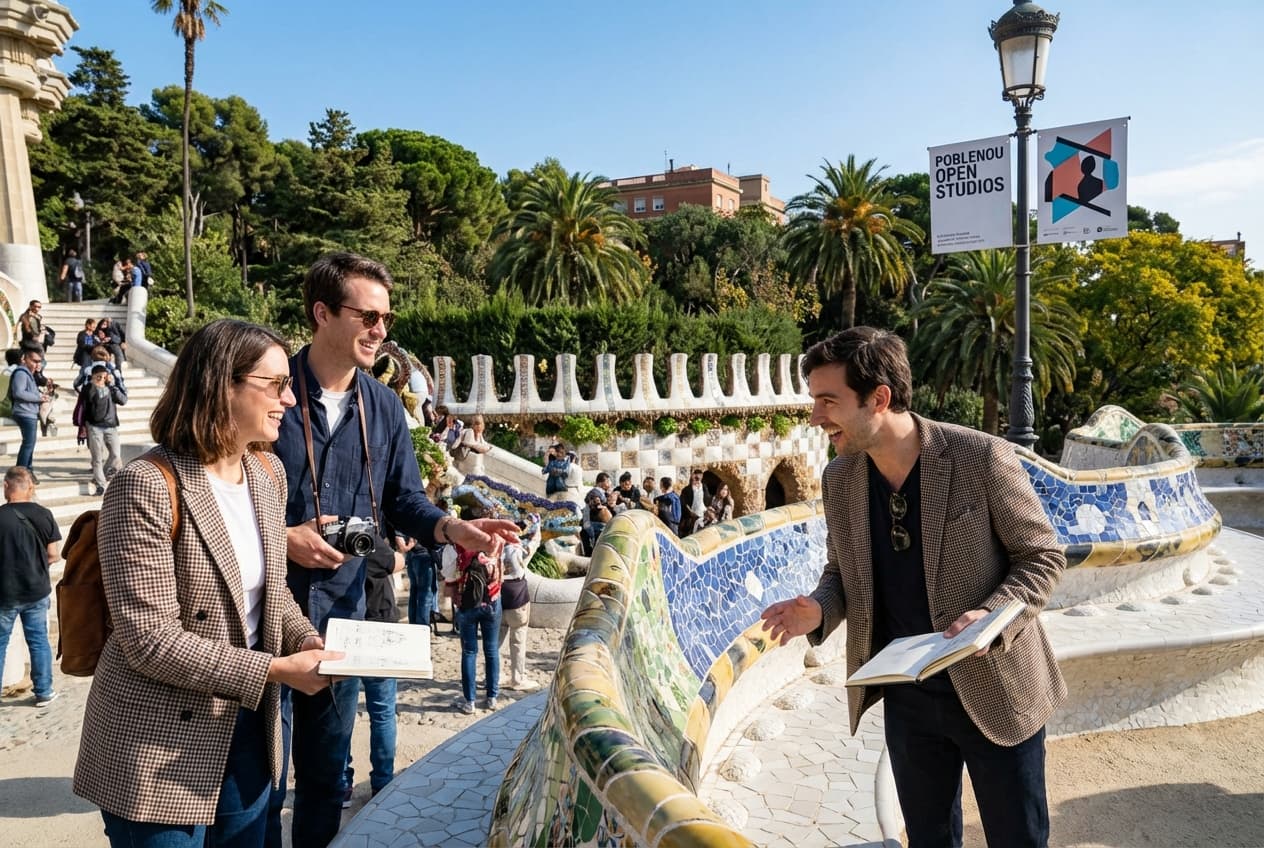
A focused, hands‑on 3‑day route from Gaudí’s sculptural Eixample to Poblenou’s working studios. Museums, showrooms, artist production centres and a practical workshop slot each day — paced for November (shorter daylight, cool temperatures) with plenty of indoor design investigation and local maker contact points.
Highlights
- Casa Batlló & Casa Milà — study of Modernisme form and material detail
- Museu del Disseny (Disseny Hub) — Spanish design collections and workshops
- Parc Güell mosaics & urban composition in lower light
- Poblenou studios: Hangar, La Escocesa, Palo Alto — working artist/ designer production
- Encants flea market for vintage/industrial finds and local showrooms
Itinerary
Day 1
Eixample deep dive: Gaudí’s masterpieces and contemporary design museum time. Indoor focus for November afternoons; evening reservation recommended for dinner.
Casa Batlló — Guided exploration of Gaudí’s interior curves
Start with the interior and detail study of Casa Batlló: flowing lines, light wells, original details and the restored ceramics. Ideal to examine material palette up close.
Tips from local experts:
- Book the earliest timed entry to catch softer light in the stained‑glass windows and avoid the peak crowds; audio guide focuses on design choices.
- The lower floor and attic show construction techniques — ask staff about where original craftsmen signed details; great for sketching.
- Accessibility: there’s an elevator to the main floors but the rooftop has steep steps—request assistance or plan to photograph façade details from Passeig de Gràcia if mobility is a concern.
Passeig de Gràcia — Design storefronts & Modernisme façades
A focused walking study of high‑design showrooms and Modernisme façades along Passeig de Gràcia; visual research time for materials, tiling and signage.
Tips from local experts:
- Window‑shopping here is research: note lighting systems and display furniture in larger showrooms for immediately local production references.
- Look up to cornices and shopfront details — many designers reuse Modernisme motifs in furniture finishings.
- Use sheltered cafés along the avenue for a midpoint break — November can be windy; sit inside near the window to observe pedestrian flows and shop displays.
Design lunch at El Nacional — curated interior and multi‑concept dining
A modern, multi‑space dining hall on Passeig de Gràcia with notable interior design and typographic signage — a good place to discuss morning observations.
Tips from local experts:
- Reserve ahead for a table and ask for a quieter corner to sketch or compare notes — the interior is a layered reference for adaptive reuse.
- Try small plates to sample regional ingredients; notice the bespoke furniture and lighting used across the rooms.
- In November, choose indoor seating by the window for daylight without the chill; huge ceilings mean interiors stay bright even after sunset.
Casa Milà — rooftop chimneys and Espai Gaudí exhibition
Study La Pedrera’s sculptural roofscape, casual flow between interior and rooftop forms, plus the contextual Espai Gaudí museum.
Tips from local experts:
- Time your roof visit for late afternoon light — November’s lower sun emphasizes texture on the chimneys.
- The Espai Gaudí space includes models and material samples; ask about any conservation notes to understand weathering in Barcelona’s climate.
- Accessibility: there is an elevator to principal levels but rooftop access uses steps; staff can advise on alternative vantage points.
Museu del Disseny (Disseny Hub Barcelona) — collections and temporary exhibitions
Two hours to see industrial design, textiles, graphics and a chance to book or arrange a short curator talk or workshop if available.
Tips from local experts:
- Check workshop and temporary exhibition schedules in advance; November often has indoor talks and curated displays that suit deep dives.
- Use the museum’s study room to examine archival objects — bring a notebook and photos for later material references.
- Pay attention to nearby Glòries architecture (visible from the plaza) as an example of recent infrastructure‑scale urban design in Barcelona.
Dinner at Alkimia — contemporary Catalan tasting menu (reservation advised)
A modern Catalan dinner in a refined, design‑aware dining space — perfect for reviewing sketches and connecting with local sensibilities.
Tips from local experts:
- Reserve the tasting menu and ask about the provenance of tableware — many local restaurants collaborate with ceramics designers.
- Use this dinner to discuss materiality and sequence: how the menu’s pacing mirrors architectural progression.
- November evenings are cool — request an interior table where lighting and acoustic design are part of the dining experience.
Day 2
Morning at Parc Güell then shift into Poblenou for vintage hunting, studio visits, and a hands‑on maker atmosphere. Nights in Poblenou are quieter and ideal for long studio dinners.
Parc Güell — mosaic surfaces and urban composition
An early slot to inspect mosaics, organic benches and the relationship between landscape and built form; perfect for studying material tessellation in low sun.
Tips from local experts:
- Book Monumental Zone tickets in advance — November light is excellent early morning for color studies of ceramic trencadís.
- Focus on transitions between terraces: note how seating ergonomics were integrated into sculptural forms, useful for furniture references.
- Dress in layers — November mornings can be crisp on the hilltop; bring a small tripod for low‑light texture shots.
Gràcia quick stroll — independent boutiques and design cafés
Light mid‑morning stroll into Gràcia to see independent ateliers and small design cafés that inspire local product ideas.
Tips from local experts:
- Look for independent textile and pattern designers on side streets — they often keep small sample books in the shop.
- November is low tourist season here; shopkeepers are more likely to chat about techniques and suppliers.
- Drop into a small café with power sockets if you need to upload images or contact local designers while on the go.
Mercat dels Encants (Els Encants Vells) — vintage, industrial and reclaimed treasures
A treasure hunt for salvaged fittings, vintage lighting, and industrial hardware — great for sourcing inspiration and materials.
Tips from local experts:
- Arrive midweek or early to find the best pieces before buyers scoop them up — vendors may hold back showpieces for collectors.
- Bring gloves and a tape measure — you’ll want to inspect patina and measure pieces for potential shipping back home.
- Ask vendors about local carpenters or metalworkers they trust for restoration — this is how many designers source local makers.
Lunch at Els Pescadors (Poblenou) — local seafood in a neighbourhood setting
A classic Poblenou restaurant loved by locals; relaxed lunch to refuel before afternoon studio visits — interior has an authentic, lived‑in atmosphere.
Tips from local experts:
- Book ahead on weekends; in November the dining room is a warm indoor refuge from the colder sea breeze.
- Sit near the back room to observe local decorative elements and ceramics used in service.
- Ask the staff about nearby artisan suppliers — chefs often work with local producers and can give contacts.
Hangar — artist production centre and studio visits
A scheduled visit to Hangar (art production centre) to see artist studios, fabrication facilities and small exhibitions — contact ahead for studio access.
Tips from local experts:
- Email ahead to schedule a short introduction to resident projects; many studios allow polite, brief photography if asked.
- Focus on fabrication rigs and shared equipment — great leads if you want to prototype in Barcelona after the trip.
- Respect working hours: late afternoons are ideal to meet artists wrapping up a day; bring a printed portfolio or business card if you wish to connect.
La Escocesa — Fàbrica de Creació studio visit
An artist factory with workshops, small galleries and makers working across media — emphasizes raw production and collaborative projects.
Tips from local experts:
- Contact the reception in advance to ask about resident designers and any small open‑studio hours; November may have fewer public events but more accessible studios.
- Observe material storage and shared tools — much design innovation here comes from improvisation and resource reuse.
- If you meet a maker, ask about local material sources (metal shops, timber yards) — this is valuable insider intel for designers.
Palo Alto Barcelona — creative courtyard for a relaxed dinner
A converted industrial complex turned creative campus with restaurants and small design businesses — an atmospheric place for an easy dinner and night‑time observation of workspace lighting.
Tips from local experts:
- In November the courtyard is quieter — indoor seating shows how studios adapt interiors; ask to see any seasonal mini‑exhibits.
- Look for pop‑up shops inside Palo Alto to find small furniture and accessory designers working locally.
- Use dinner time to catalogue textures you saw in the day; interior lighting here is useful reference for evening presentation moods.
Day 3
Born + showrooms: a day for small design boutiques, an institutional visit to a design school, showroom scouting and a practical workshop session to finish.
El Born neighbourhood walk — independent designers and atelier windows
Morning walk to discover small furniture and object designers, independent perfumers, and artisan workshops hidden in Born’s lanes.
Tips from local experts:
- Spend time in side streets (Carrer dels Carders, Carrer de la Fusina) — small ateliers often have the best material samples in the window.
- November mornings are cool; pop into shops for conversational time — shop owners are more open to discuss technique in low season.
- Notice signwriting and shopfront materials — Born is a living reference for handcrafted signage and small‑scale retail displays.
El Born Centre de Cultura i Memòria — adaptive reuse and exhibition space
A look at a major interior reuse project: iron market hall turned cultural space; good for studying structural exposure and interpretation of heritage for contemporary uses.
Tips from local experts:
- The interior demonstrates how industrial bones are retained in adaptive reuse — useful if you’re considering adaptive strategies for studio design.
- Check the small temporary exhibitions for local craft and design shows, common in autumn.
- Photography: interior ironwork details and the glass roof make a good low‑sun sketching opportunity; bring a compact sketchbook.
ELISAVA — visit a design school’s exhibition or shop (arrange ahead)
A scheduled visit to ELISAVA (Barcelona School of Design and Engineering) to see student work, small exhibitions and possibly meet a professor or student collective.
Tips from local experts:
- Contact ELISAVA ahead to ask about studio visits or small thesis exhibits — November often has mid‑term shows and critique sessions.
- Student work shows are great for spotting emerging material experiments and new local design names to follow.
- Bring a concise introduction (one‑page portfolio) if you want to connect with students or staff about collaboration.
Mercat de Santa Caterina — architecture and market design; quick lunch
Study Enric Miralles’ market roof and the market’s contemporary interior stalls while enjoying fresh local food — a design + food stop.
Tips from local experts:
- Admire the colourful, undulating roof tiles as an example of contemporary interventions in historic fabrics.
- Use indoor stalls to note display techniques for food and object presentation — great ideas for product merchandising.
- November lunch is quieter; try small stall vendors to compare how local producers use packaging and labels.
BD Barcelona Design showroom — contemporary Catalan furniture and object design
Visit a locally influential showroom to see pieces by Catalan designers and how local brands present their collections in a curated retail space.
Tips from local experts:
- Ask the showroom staff about material options and production runs — many local manufacturers offer limited editions.
- Take note of display systems and lighting rigs; Barcelona showrooms often highlight products with simple architectural staging.
- If interested in purchasing or commissions, request catalogue sheets and local transporter recommendations for export.
Design workshop (Disseny Hub or museum-run practical session) — book in advance
Hands‑on closing session: a short practical workshop (materials, prototyping, or small object making) arranged with Disseny Hub or a local maker; ideal capstone to synthesize observations.
Tips from local experts:
- Book this workshop well in advance (Disseny Hub schedules fill quickly); November workshops tend to be indoors and well equipped.
- Choose a session that emphasizes materials you noted during the trip (ceramics, wood, metal); bring reference sketches to adapt into a prototype.
- Workshops are an opportunity to gather maker contacts; ask the teacher for local supplier recommendations and small batch producers.
Farewell dinner in El Born — Bar del Pla or similar local favourite
A relaxed final dinner in Born to share findings, contacts and to capture last sketches in a convivial local place.
Tips from local experts:
- Choose a table inside to stay warm — November nights are crisp and the Born area is atmospheric after dark.
- Use dinner to exchange contact notes and plan any follow‑up commissions or research visits with local makers you met.
- Ask staff about seasonal local ingredients and any local ceramic or textile makers they know — great for post‑trip follow up.

